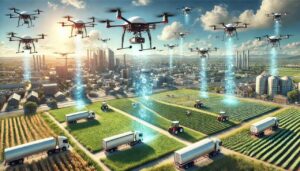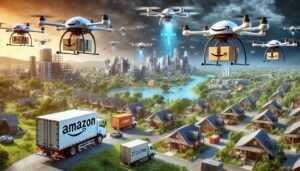
How drones are employed by police forces for surveillance, crime scene investigation, and crowd monitoring, as well as securing national borders.
Drones in Law Enforcement and Border Security: The Watchful Eyes in the Sky
In an era where technology continually reshapes our approach to public safety and national security, drones have emerged as a game-changing tool for law enforcement agencies and border protection units worldwide. These unmanned aerial vehicles (UAVs) are revolutionizing how authorities conduct surveillance, investigate crime scenes, monitor crowds, and secure national borders. This blog explores the multifaceted applications of drones in these critical domains, examining real-world examples and considering the implications of this technological shift.
Aerial Sentinels: Drones in Police Operations
aw enforcement agencies across the globe have increasingly integrated drones into their operational toolkit, leveraging their versatility and cost-effectiveness compared to traditional helicopter units. In the United Kingdom, the Devon and Cornwall Police force has been at the forefront of drone adoption. Their fleet of DJI Mavic Enterprise drones, equipped with high-resolution cameras and thermal imaging sensors, has proven invaluable in a variety of scenarios.

In a notable case from 2018, Devon and Cornwall Police utilized a drone to locate a disoriented rape victim in a remote area. The drone’s thermal imaging capabilities allowed officers to pinpoint the victim’s location in darkness, leading to a swift rescue. This incident underscores the potential of drone technology to save lives in time-critical situations.
Crime scene investigation has also been transformed by the integration of drones. The Los Angeles Police Department (LAPD) has employed drones to create detailed 3D maps of crime scenes, providing investigators with comprehensive visual data that can be analyzed long after the physical evidence has been collected. In 2019, the LAPD used a drone to map the scene of a high-profile shooting in Thousand Oaks, California, allowing detectives to reconstruct the event with unprecedented precision.
Crowd monitoring is another area where drones have proven their worth. During the 2019 Hong Kong protests, the Hong Kong Police Force deployed drones equipped with high-zoom cameras to monitor crowd movements and identify potential flashpoints. While this application raised privacy concerns among some activists, it exemplifies the powerful surveillance capabilities that drones offer to law enforcement agencies.
Guardians of the Border: Drones in Border Security
The vast expanses of national borders present unique challenges for security forces, challenges that drones are uniquely suited to address. The United States Customs and Border Protection (CBP) has been at the vanguard of incorporating drones into border security operations.
The CBP’s fleet of MQ-9 Predator B drones, also known as “Guardians,” patrol vast stretches of the U.S.-Mexico border, providing real-time surveillance data to ground units. In fiscal year 2020, these drones logged over 12,000 flight hours, contributing to the apprehension of 4,975 individuals and the seizure of 30,465 pounds of narcotics. The ability of these UAVs to cover large areas efficiently has significantly enhanced the CBP’s situational awareness and response capabilities.
In Europe, the European Border and Coast Guard Agency (Frontex) has embraced drone technology to monitor the Mediterranean Sea, a critical route for irregular migration. In 2019, Frontex launched a pilot project using long-endurance drones to patrol the waters between Greece and Turkey. These drones, capable of flying for over 20 hours, have provided invaluable data on vessel movements, enabling more targeted and efficient interventions by maritime authorities.
Navigating the Promises and Perils
The integration of drones into law enforcement and border security operations represents a significant leap forward in technological capabilities. These aerial platforms offer unprecedented situational awareness, cost-effective surveillance, and the ability to access areas that would be dangerous or impractical for human officers to reach.
However, this technological advancement is not without its challenges. Privacy concerns, the potential for misuse, and the need for robust regulatory frameworks are all critical issues that must be addressed as the use of drones in these domains becomes more widespread.
As we look to the future, it is clear that drones will play an increasingly pivotal role in maintaining public safety and securing national borders. The key lies in striking a balance between leveraging the benefits of this technology and safeguarding civil liberties. By fostering transparent policies, promoting ethical use, and continuing to innovate, we can ensure that drones serve as a force for good in the hands of those tasked with protecting our communities and borders.
In this new era of aerial surveillance and security, the sky is quite literally the limit. As drone technology continues to evolve, so too will its applications in law enforcement and border security, promising a future where public safety is enhanced through the watchful eyes in the sky.








